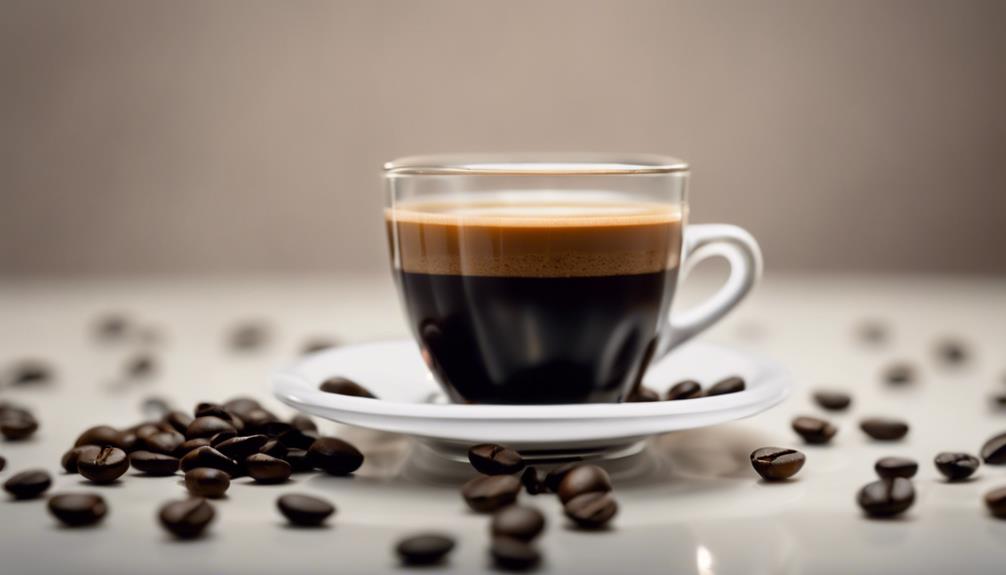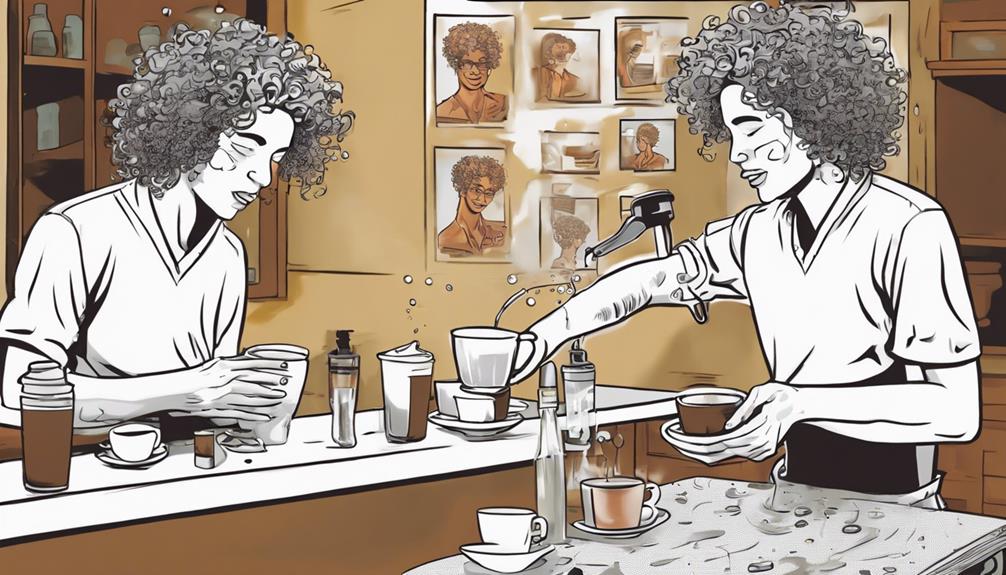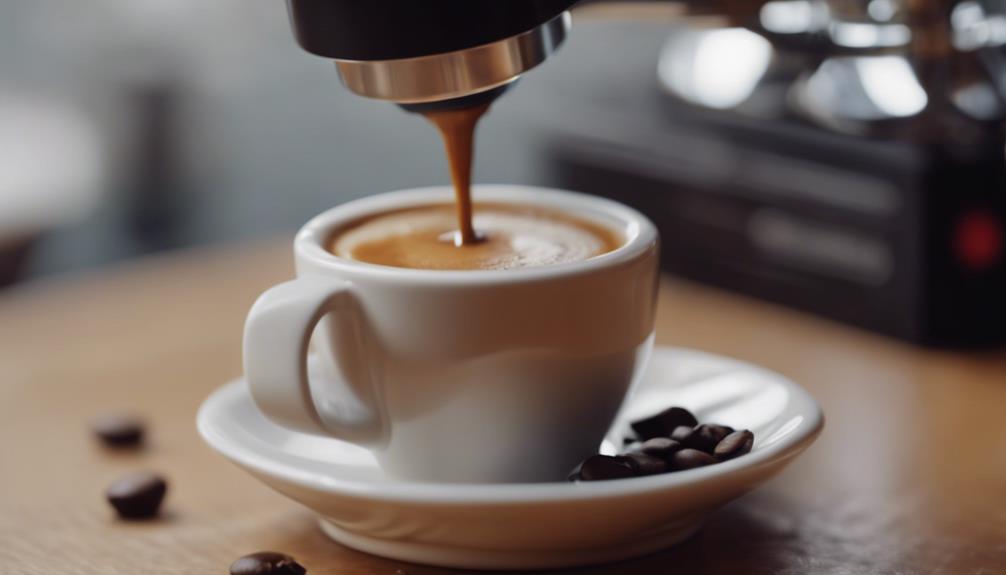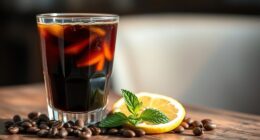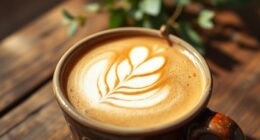You may be curious about the caffeine content in a shot of espresso, with approximately 63 mg per 1-ounce serving. It’s important to note that this amount can vary based on factors such as the type of coffee beans used, the roast level, and the brewing temperature. For instance, Starbucks typically has around 75 mg of caffeine per shot. If you opt for a double shot, you can expect roughly 125-150 mg of caffeine. There is more to explore when it comes to caffeine and espresso – do you want to learn about the differences between espresso and brewed coffee, or how caffeine impacts your body?
Key Takeaways
- A standard shot of espresso contains approximately 63 mg of caffeine per 1-ounce serving.
- Starbucks espresso averages around 75 mg of caffeine per shot, slightly higher than the standard amount.
- Decaf espresso, on the other hand, contains about 0.3 mg of caffeine per shot, making it a low-caffeine option.
- Espresso has a higher caffeine concentration per ounce compared to brewed coffee, with brewed coffee averaging 8.1-15 mg per ounce.
Caffeine Content in Espresso
When you order a standard shot of espresso, you can expect to get around 63 milligrams of caffeine in that 1-ounce serving, although this amount can vary depending on the brand and preparation method. This caffeine content is relatively high compared to brewed coffee, which contains about 95 mg of caffeine per 8-ounce cup.
However, espresso has a higher caffeine concentration per ounce, making it a more potent pick-me-up.
If you're looking for an extra boost, a double shot of espresso, also known as a doppio, typically contains around 125-150 mg of caffeine.
Even decaf espresso, which has undergone a decaffeination process, still contains a small amount of caffeine, about 0.3 mg per shot.
It's worth noting that some brands, like Starbucks, have a slightly higher caffeine content in their espresso shots, averaging around 75 mg per shot.
Factors Affecting Caffeine Levels
As you explore the world of espresso, you'll discover that several factors influence the amount of caffeine in your shot.
You'll find that the type of coffee beans used, the level of roasting, and even the serving size all play a significant role in determining the caffeine content.
Bean Type Matters
You'll get a different caffeine kick depending on the type of coffee beans used in your shot of espresso. The bean type greatly impacts caffeine levels, and it's important to know the difference.
Robusta beans, for instance, contain about 2.2-2.7% caffeine, while Arabica beans have approximately 1.2-1.5% caffeine. This means that if you're drinking an espresso made from Robusta beans, you'll get a stronger caffeine kick compared to one made from Arabica beans.
When it comes to espresso blends, the proportion of each bean type used affects the caffeine content. So, if you're unsure about the type of beans used, you might get varying caffeine levels.
Additionally, the roasting process also plays a role in caffeine levels, although we'll dive deeper into that later. For now, it's important to remember that the type of coffee beans used is a key factor in determining the caffeine levels in your shot of espresso.
Roast Level Impact
While the type of coffee beans used is a significant factor in determining caffeine levels, the roast level of those beans also plays a critical role in how much caffeine makes it into your shot of espresso.
You might be surprised to learn that lighter roast levels retain more caffeine compared to darker roasts. This is because the roasting process breaks down some of the caffeine content, resulting in lower levels in darker roasts.
However, it's crucial to remember that the type of coffee bean you use also matters, with Arabica beans generally containing less caffeine than Robusta beans, regardless of roast level.
When brewing your espresso, the ideal temperature and brewing time can affect caffeine extraction. Aim for a temperature between 190°F and 205°F and a brewing time of 25 to 30 seconds for the best results.
The finer grind size used for espresso also increases the surface area, enhancing caffeine extraction during brewing. By considering these factors, you can maximize the caffeine content of your espresso shot.
Serving Size Effects
When you order an espresso, the serving size considerably impacts the total amount of caffeine you're getting, especially considering that a standard 1-ounce shot packs around 63 milligrams of caffeine.
This serving size effect is essential because espresso shots are typically consumed in smaller quantities compared to larger brewed coffee servings.
What's more, espresso is more concentrated in caffeine per ounce, containing about 30-50 mg of caffeine per ounce, compared to brewed coffee's 8.1-15 mg per ounce.
The grind size of the coffee beans used for espresso also affects caffeine extraction. Finer grounds allow for more efficient extraction during brewing, which can impact the overall caffeine concentration in each shot.
As you can see, serving size is just one of the factors that influence your caffeine intake. Other variables, such as water temperature and brewing time, can also impact caffeine extraction, leading to variability in espresso caffeine levels.
Espresso Vs Brewed Coffee Caffeine
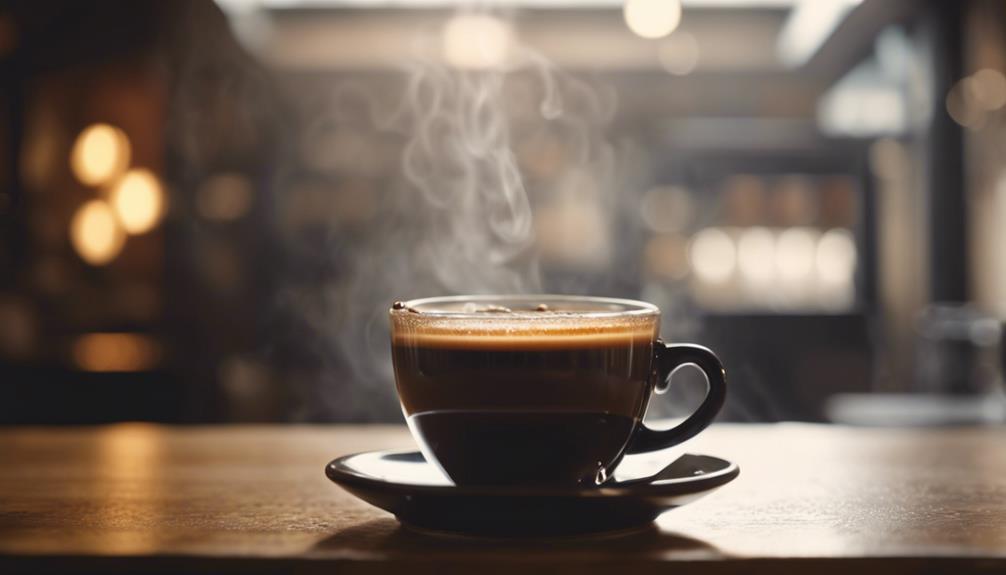
One key difference between espresso and brewed coffee is that a standard 1-ounce shot of espresso packs a more concentrated caffeine punch than an 8-ounce cup of brewed coffee.
You might be surprised to learn that despite this, an 8-ounce serving of brewed coffee actually contains more total caffeine due to its larger volume.
Here's a breakdown of the caffeine content in each:
- Caffeine per ounce: Espresso provides about 63 mg per ounce, while brewed coffee delivers around 12 mg per ounce.
- Total caffeine: A standard 1-ounce shot of espresso contains approximately 63 mg of caffeine, whereas an 8-ounce cup of brewed coffee typically contains around 95 mg of caffeine.
- Double shot comparison: A double shot of espresso (2 ounces) can contain around 125 mg of caffeine, making it comparable to the caffeine content found in a standard 8-ounce cup of brewed coffee.
Keep in mind that factors like bean type, grind size, and brewing method can influence the caffeine content in both espresso and brewed coffee.
When it comes to your daily caffeine intake, understanding the amount in each serving is essential.
Caffeine in Espresso Drinks Explained
As you explore the world of espresso drinks, you're probably wondering how much caffeine you're getting in each cup.
You'll soon discover that the amount of caffeine varies depending on the type of drink and the number of espresso shots it contains.
Let's break down the typical caffeine content in popular espresso drinks, from lattes to americanos, to give you a better understanding of what you're sipping on.
Espresso Shot Caffeine Content
In a typical serving, you can expect a standard one-ounce shot of espresso to pack around 63 milligrams of caffeine, although this amount can fluctuate slightly depending on the brand and preparation method. This is a considerable amount, especially when compared to brewed coffee, which contains about 95 milligrams of caffeine in an 8-ounce serving. That's roughly 12 milligrams of caffeine per ounce, compared to espresso's 63 milligrams per ounce.
Here are a few key facts to keep in mind:
- Espresso has a higher caffeine concentration per ounce compared to brewed coffee.
- A double shot of espresso, known as a doppio, contains around 125 to 150 milligrams of caffeine, depending on the serving size and coffee used.
- Popular coffee chains like Starbucks serve espresso shots with approximately 75 milligrams of caffeine each, while other brands may vary slightly.
When you order espresso drinks like lattes and cappuccinos, keep in mind that they typically contain one to three shots of espresso, considerably contributing to their overall caffeine content.
Caffeine in Espresso Drinks
You're likely to get a significant caffeine boost from espresso drinks like lattes and cappuccinos, which typically contain one to three shots of espresso, each packing around 63 to 75 milligrams of caffeine.
This means you can expect a total of 75 to 225 milligrams or more of caffeine per drink, depending on the number of shots used. At Starbucks, for instance, a single shot of espresso has 75 milligrams of caffeine, while a double shot contains about 150 milligrams.
Mocha drinks can have even more caffeine, up to 180 milligrams for a large size, due to the addition of chocolate, which also contains caffeine.
If you prefer an americano, the caffeine content can vary, with short sizes containing 75 milligrams and venti sizes reaching up to 300 milligrams, depending on the number of espresso shots used.
Espresso Vs. Coffee Caffeine
When comparing the caffeine content of espresso and coffee, it's essential to recognize that a typical shot of espresso packs a more concentrated punch, with approximately 63 milligrams of caffeine per ounce. In contrast, an 8-ounce cup of brewed coffee contains around 95 milligrams of caffeine. This means that a single shot of espresso has a higher caffeine concentration per ounce than brewed coffee.
Here are some key points to keep in mind:
- A double shot of espresso, also known as a doppio, contains about 125 mg of caffeine, equivalent to a standard 8-ounce cup of coffee.
- Espresso has a higher caffeine concentration per ounce, with about 63 mg compared to brewed coffee's 12 mg per ounce.
- The caffeine content in espresso drinks varies depending on the number of shots used, such as a cappuccino with 75 mg for a single shot or 150 mg for a double shot.
As you explore the world of coffee drinks, remember that espresso is a more potent source of caffeine than brewed coffee. Whether you're ordering a latte or a cappuccino, the number of shots used will impact the overall caffeine content of your drink.
Health Aspects of Caffeine Consumption
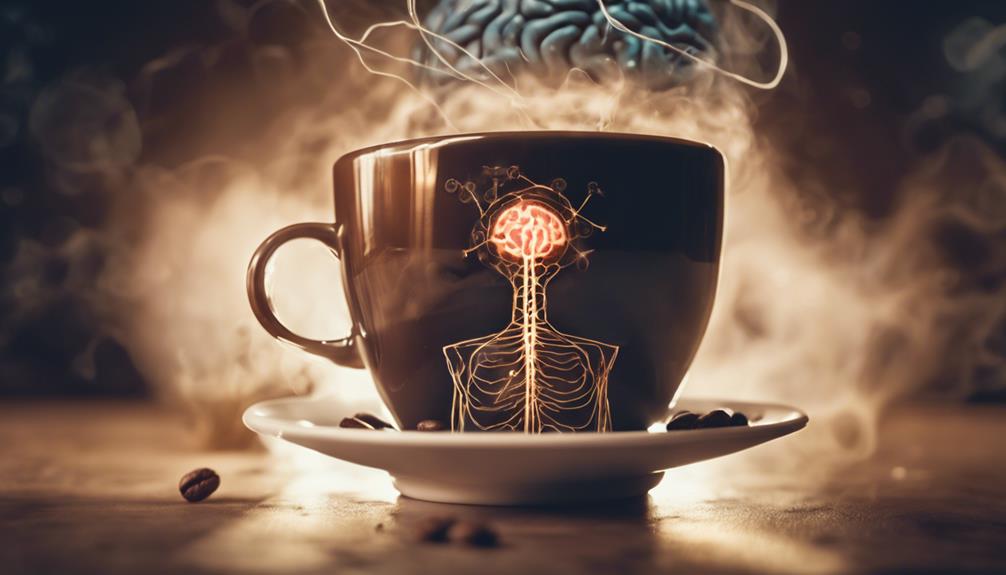
Caffeine's impact on your health can be a double-edged sword, offering benefits like improved cognitive function and mood when consumed in moderation, but triggering adverse effects when taken excessively.
When you stick to moderate caffeine consumption, typically 400-600 mg per day, you may experience health benefits like reduced risks of diseases such as Parkinson's and Type 2 diabetes. However, be cautious not to overdo it, as excessive caffeine intake can lead to anxiety, sleep disturbances, and heart palpitations.
As you consume caffeine, remember that you're not alone – pregnant individuals, for instance, should limit their intake to 200 mg per day to guarantee a healthy fetal development.
Additionally, timing your coffee breaks is vital, especially around iron-rich meals, as caffeine can interfere with iron absorption. This is particularly important for individuals with iron deficiency or anemia.
Decaf Coffee and Caffeine Content
Decaf coffee, often misunderstood as a caffeine-free alternative, typically contains a small amount of caffeine, ranging from 0-7 milligrams per 8-ounce cup.
This may come as a surprise to you, but it's important to understand the caffeine content in decaf coffee. When you opt for a shot of decaf espresso, you're looking at around 0.3 milligrams of caffeine. Not bad if you're sensitive to caffeine.
Here are three key takeaways to keep in mind:
- Decaffeination process variability: The process of removing caffeine doesn't always result in a complete removal, leading to differences in caffeine content between brands and preparation methods.
- Caffeine per cup varies: Some decaf coffee products can contain as much as 53 milligrams of caffeine, so it's important to check the brand information.
- Retains health benefits: Despite having less caffeine, decaf coffee still packs antioxidants and important nutrients found in regular coffee.
Caffeine's Impact on Metabolism
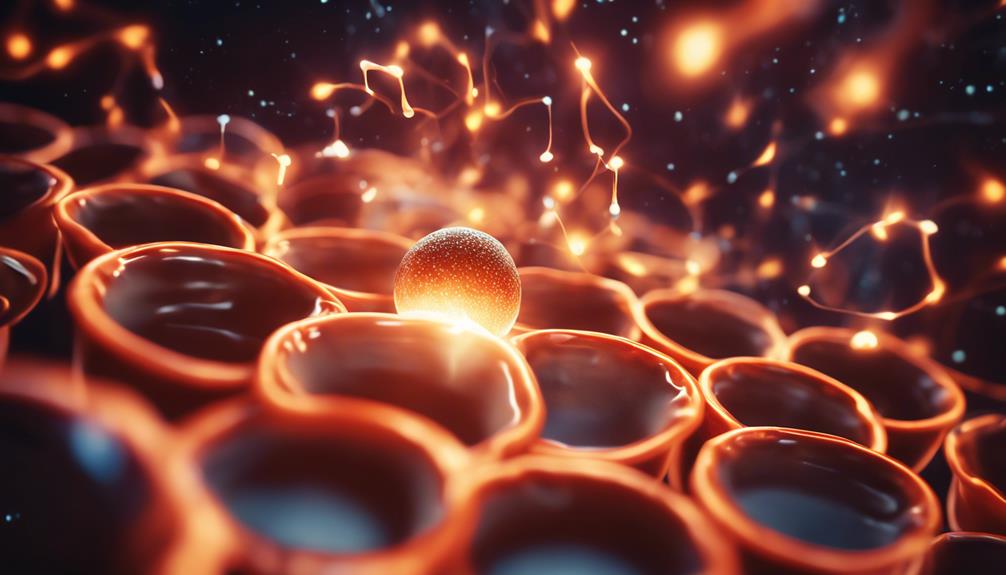
You're about to get a metabolic boost, as the stimulant properties of caffeine can increase your resting metabolic rate by 3-11% for a few hours after consumption. This temporary metabolic surge can enhance your physical performance, improving endurance and strength during exercise.
Additionally, caffeine may increase energy expenditure, which can aid in weight management strategies for some individuals. However, it's important to note that the impact of caffeine on metabolism varies among individuals, often influenced by genetic differences in caffeine metabolism.
As you enjoy your shot of espresso, remember that caffeine stimulates fat release from tissues, which can contribute to its metabolism-boosting effects. But don't get too comfortable – regular caffeine consumption can lead to a tolerance effect, potentially diminishing its metabolic benefits over time.
Espresso Basics and Preparation
As you savor the metabolic boost from your shot of espresso, let's explore the art of preparing this concentrated coffee beverage, starting with the basics. Espresso is a unique coffee experience that requires precision and attention to detail. To brew the perfect shot, you'll need to master the preparation process.
Here are three essential factors to get right:
- Temperature: The ideal brewing temperature for espresso extraction ranges from 190°F to 205°F.
- Grind size: The grind size should be fine, similar to table salt, to guarantee maximum flavor and caffeine extraction during brewing.
- Extraction time: Aim for an ideal extraction time of 25 to 30 seconds to bring out the full flavor and aroma of your coffee.
When done correctly, the result is a rich, full-bodied espresso with a creamy layer of crema on top. This distinctive layer is a sign of quality and proper extraction.
Caffeine Comparison and Recommendations

When it comes to caffeine content, a standard shot of espresso packs a more concentrated punch than a typical cup of brewed coffee. You might be surprised to learn that espresso contains a higher amount of caffeine per ounce than regular coffee. In fact, a single shot of espresso provides around 63-75 mg of caffeine, compared to 12 mg per ounce in brewed coffee.
To put this into perspective, you'd need to drink about four to five cups of coffee to match the amount of caffeine in just six shots of espresso. The FDA recommends a maximum daily caffeine intake of 400 mg for most adults, which is equivalent to about six shots of espresso or four to five cups of brewed coffee.
However, it's important to reflect on your individual caffeine sensitivity and adjust your intake accordingly. If you're pregnant, you should restrict your caffeine consumption to 200 mg per day, which is about three shots of espresso.
Be mindful of your caffeine intake to avoid adverse effects and enjoy your espresso responsibly.
Frequently Asked Questions
Is 2 Shots of Espresso a Lot of Caffeine?
You're wondering if two shots of espresso are a lot of caffeine? Well, with around 126-150 mg, it's within the safe daily limit for most, but may cause issues for those sensitive to caffeine or pregnant individuals.
How Much Caffeine Is in a Single Shot of Espresso?
You're wondering how much caffeine is in a single shot of espresso? Typically, you're looking at around 63 milligrams, but it can vary by brand, like Starbucks, which packs about 75 milligrams per shot. Caffeine content in espresso explained: The amount of caffeine in espresso can also depend on factors such as the type of coffee bean used and the brewing method. Additionally, the size of the shot of espresso can also impact the caffeine content, as a larger serving will naturally contain more caffeine. It’s important to be mindful of your caffeine intake, especially if you’re sensitive to it, and consider these factors when enjoying a shot of espresso.
How Much Caffeine Is in 1 Shot of Starbucks Espresso?
You grab a morning pick-me-up at Starbucks, wondering how much caffeine is in that 1-shot espresso. The answer is approximately 75 mg, which is higher than the average shot from other brands.
What Is Considered 1 Shot of Espresso?
You're wondering what makes one shot of espresso. Typically, you'll find it's 1 ounce or 30-50 ml in volume, with a rich flavor and concentrated caffeine content, brewed by forcing hot water through finely-ground coffee under high pressure.
Conclusion
Savoring the sip, you've reached the finale of your espresso exploration. The buzz of caffeine still lingers, like a lively spark in your veins.
From beans to brew, you've uncovered the secrets of this stimulating sipper.
Now, energized and enlightened, you're ready to craft your perfect cup, carefully calibrating the caffeine kick to suit your style.
Cheers to the ultimate espresso experience!
